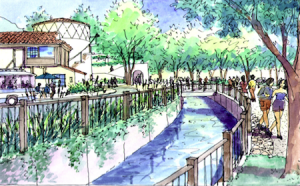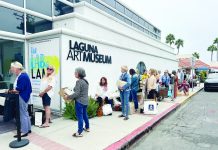
By a 4-1 vote, Laguna Beach’s City Council endorsed a plan disproving the Joni Mitchell song about paving paradise to put up a parking lot. Their plan for a long-sought village entrance will un-pave a parking lot, summoning paradise in the form of an urban park where asphalt now sprawls beside City Hall, along with adding an expensive parking garage nearby.
According to the $35 million proposal outlined by Mayor Pro-Tem Elizabeth Pearson, pedestrians heading to the festivals from downtown will no longer have to negotiate a barren concrete expanse, separated from a field of parked cars by a hedge and buffered from the steady traffic on Laguna Canyon Road by nothing more than parking meters. Instead, they’ll enter a park just past City Hall and stroll along a meandering path through verdant terrain punctuated by seating areas, gathering places and stone walls.
Pearson and Council member Toni Iseman worked together to develop the concept, but eventually diverged on certain details and presented two different plans on Tuesday.
Addressing concerns that the scope of the project is too narrow to solve Laguna’s traffic congestion, council member Robert Whalen described the village entrance as “one component of a larger parking need for the whole city,” adding, “This is not the answer and is not the end. This is the beginning of putting together a plan that makes sense for the whole community.”
In addition to a linear park extending from City Hall out to the festivals, Pearson’s plan incorporates a 506-space, four-floor parking garage, flanked by 79 surface parking spaces. Originally priced between $33 to $55 million, Pearson suggested some cost-saving measures to reduce the price to just over $35 million.
Iseman, who cast the dissenting vote, said fumes emanating from the sewer lift station on the property should be addressed before pouring money into the project. She also expressed grave concerns about the price tag.
Her blueprint encompassed a smaller three-floor parking structure with 372 spaces flanked by 79 surface spaces, and a reduced park area in the form of a 30-foot wide “greenway” along Forest Avenue to Laguna Canyon Road, freeing up 90 more surface spaces, and estimated to cost $30 million. Iseman also suggested that financing through iBank could lead to additional cost savings.
To further supplement her smaller garage, Iseman suggested capturing 40 more parking spaces in the summer by transforming the tennis courts on the Festival of Arts’ grounds into a parking area during the 10-week summer festival season.
Thirty-five people shared their views at the special meeting in Council Chambers, which was filled to capacity.
Iseman’s fear that over spending on the village entrance would draw funds away from other town priorities resonated with some residents, though the smaller park did not.
Resident Barbara Metzger worried that “other things may go begging” and that the city should look at “what we won’t have if we have this structure.” Still, she opposed a smaller park, preferring to save costs on the structure alone.
Resident Sue Kempf agreed. “I like Toni’s price on the park, but I like the size of Elizabeth’s,” she said.
City officials intend to hire an urban designer for help in melding its projects together to the best advantage. Aside from the proposed village entrance project they include a parking management plan, a review of the downtown specific plan, and a “complete streets” transition, making streets accessible to all types of mobility.
The project “will not exhaust all of our money,” said Whalen, who works on financing such projects professionally. Whalen said that Laguna’s “very, very strong credit rating” coupled with virtually no debt means the city would qualify for a highly rated bond with low interest rates. Thanks to the past prudence of city officials “we have a debt capacity that is well above $50 million if we as a community want to use it,” he said.
Most of the public speakers urged council members to “move forward,” since, as local resident and developer Joe Hanauer said, “18 years is long enough,” a reference to the time lapsed since the original village entrance task force convened in 1995.
Greg Vail, a former planning commission member, confessed that he was part of that original task force when he had a full head of hair and kids in diapers. Now that he’s balding and his kids are in college, he urged the council to act. Aaron Talarico, whose children are now in diapers, said he hoped not to eventually be making the same speech as Vail.
Some highlighted the importance of peripheral parking options, including expanding the use of the ACT V parking lot in Laguna Canyon, even building a structure there. “I love your park, Elizabeth, but please eliminate the cars before they get into town,” said Rebecca Connolly, who lives in Thurston Park and deplores the congestion and the pollution from idling cars in Laguna Canyon. “To me peripheral parking makes sense,” agreed Sharon Risley, calling the project “a parking entrance, not a village entrance.”
Pearson later pointed out that the project does not preclude pursuing peripheral parking, such as current city negotiations over control of the Aliso Beach parking lot.
Representatives of the Festival of Arts, Laguna Playhouse and Chamber of Commerce endorsed Pearson’s proposal and opposed the tennis court parking option.
Festival of Arts president Fred Sattler cautioned that the Festival’s lease incorporates the tennis courts and any amendment would require that all parties agree to all terms.
Chamber executive director Kristine Thalman expressed concern that use of the tennis courts for parking would require a new EIR.
Though some residents opposed the structure altogether, most supported a multi-level structure since it would not obstruct views and would remain under the city’s height limit.
Council member Steve Dicterow pointed out the value of taking advantage of current low interest rates and construction costs.
“I think there are a lot of people who aren’t in the room tonight who aren’t being represented,” rued Iseman, who said that she opposed the vote because of the park costs, but that she supported the rest of the motion. “I’m just surprised we can spend so much money with such ease,” she said.
Mayor Kelly Boyd supported the project but said he would like the community to endorse debt financing of the proposal, saying such a large expense should not be decided by the council alone.
Pearson and Whalen will form a sub-committee to tweak the proposal based on comments and map out a financing strategy, returning to the council in May.





[…] In a 4-1 vote with Iseman dissenting, the council favored Pearson’s option of a public park wrapping around the corner and a four-level, 500-space parking structure estimated to cost between $33 and $55 million. […]
[…] on the project intermittently over the last 10 years. They presented diverging plans in March. In a 4-1 vote with Iseman dissenting, the council favored Pearson’s option, largely the same as that […]